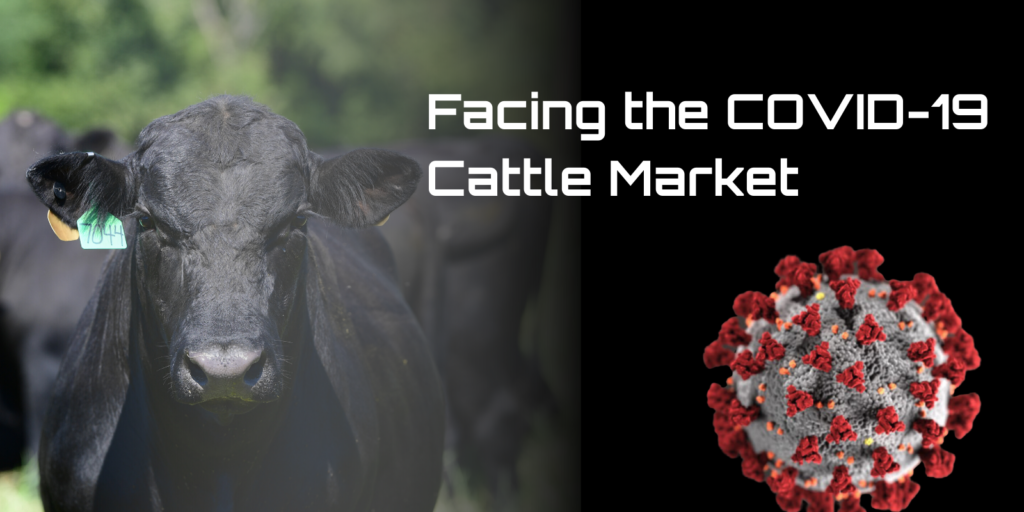![]()
I hope and pray that you are staying safe from the coronavirus that’s turned our world upside down. First priority is personal safety during this time. Once that is secure, I think most folks, including me, start to worry about economic security. How does this pandemic affect my pocket book both near term and long term?
Unfortunately, no one knows exactly how long this virus will wreak havoc on life as we once knew it. History tells us that beef is a luxury for consumers and when they lose confidence in their economic security, they will opt for lower priced alternatives such as pork or chicken. The current market forecast predicts that a 1350 pound fed steer will be worth 80 cents per pound in June. Earlier this year, that same June calf was projected to be worth $1.20 per pound. This 40 cents per pound drop translates to a $540 per steer reduction coming from the packers. Past experience indicates that over time this loss of value will find its way to the cow-calf producer. Bottom line, we should prepare for our calves to be worth $540 less at some point in the future. Personally, I’ve seen these dynamics play out many times over the past 50 plus years including the dairy buy-outs, mad cow disease and several cattle cycles.
Market could get worse before it gets better
Most certainly the cattle market will get unbelievably better at some point in the future but before that happens, things will likely become unbelievably worse. As both beef and dairy producers start to liquidate their production capacity, more beef enters the market as those cows are slaughtered. This avalanche of cattle overwhelms slaughter capacity, cold storage capacity and consumer appetite causing a violent down-stroke of live cattle prices. Similarly, when the economy starts to turn around and forecasts are more optimistic, the reverse happens and a strong upswing in prices can be expected.
Below are the top 10 things we at Legends Cattle Company are considering in order to survive the current market disaster and to benefit from the future market upturn.
Hope for the best but prepare for the worst
There’s no need to panic; however, it would be a mistake not to accept the new market realities and start making plans now. The two major options are a) sell some cattle now before things get worse or b) hold/expand for the next 12 to 18 months. This decision is largely driven by liquidity and stocking capacity.
Evaluate your liquidity
All markets are racing to liquidity and you shouldn’t act any different. Liquidity is the key to weathering this storm and seeing the rainbow on the other side. How many months of production expenses do you have covered in the bank or in un-drawn credit? Can you work with your banker to increase your credit capacity in order to weather this storm or take advantage of the buying opportunities?
Evaluate your stocking capacity
If liquidity isn’t a barrier, do you have the grass needed to carry weaned calves until the market improves? Do you have opportunities to take over new pasture leases or enter into contract grazing arrangements? Those opportunities might be more plentiful if your neighbors are liquidating their operations.
Evaluate your non-farm income and expenses
Most cattle ranchers have lives outside of their cattle operation. How is your non-farm income going to trend over the next 12 to 18 months? Consider if you need to cut your non-farm expenses to adjust to the new market realities.
Rethink your entire operational model
You’ve likely developed a certain rhythm with supplements, vaccinations, mineral programs, breeding programs, and other practices. The marginal cost versus marginal value equation has changed dramatically and those practices you started doing that were profitable when calf prices were $170/pound might not make sense any longer. Spending $600 to get one more calf is really smart when calves are worth $900, however, it is losing you money if that extra calf is only worth $500.
Implement 365-day grazing
There is no quicker way to reduce operational costs. This can also be a mechanism to increase stocking capacity. However, it may require some liquidity and capital investment to get started. I encourage you to access several of the resources we have available on Legends’ 365-day grazing program.
Take a hard look at discretionary spending
Determine how to get by with what you have. Now is not the time to buy a new pickup or tractor unless you have substantial excess liquidity.
Take advantage of government support programs
Government actions and decisions have contributed to the market challenges we face. Don’t let your pride get in the way of taking the support they are offering to keep you afloat.
Reduce cost of bull service
Purchasing a Legends commercial breeding bull instead of a high-priced registered bull can leave you thousands of dollars ahead. We use the best breeding bulls we can find which is why we have started using Legends breeding bulls exclusively. We find that our bulls also sire offspring that excel in a low-cost environment.
Drive labor efficiencies
Evaluate the time spent on productive versus unproductive activities. Do you spend time trying to remember how to mix herbicide for weed control every summer? Write down your ‘recipe’ this year and make sure to keep it where you can find it next year.
Let us know what initiatives are working on your ranch. We’d love to hear from you!
View our Bull Sale Catalog and give Jeff a call at 903-560-8311.
Every day is sale day at Legends!

